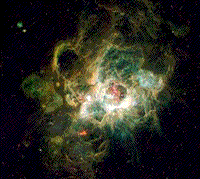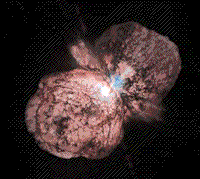

Even more massive stars, originally with 8 to 50+ solar masses, burn their gaseous fuel (in the plasma state [atoms are ionized]) much more rapidly until nuclear processes force the gases away at high velocities from the core in an explosion whose early stage may be seen from Earth for a few years as a hugely luminous event called a Supernova. A prime example is this HST view of the Crab Nebula, shown below on the top; another is Eta Carinae, bottom, in which a combination of red and UV filter images from HST shows an apparent "cloud" of matter which is actually mainly a light burst from this supernova, now some 10 billion miles across, that resulted from the explosion of a star 100x more massive than our Sun.
 |
 |
In February, 1987 the brightest supernova in nearly 500 years, SN1987A (located in the Large Magellanic Cloud), was discovered in the southern hemisphere skies from an Observatory in Chile. Since then, it is being continuously monitored both from Earth and from the HST, providing a "stellar" example of the self-destruction of a star by catastrophic explosion. The event began about 167,000 years ago, based on distance measurements. In its last moments, the star first cast off an envelope of gases as it expanded to a Red Giant, evolving rapidly into a Blue Giant. As its core collapsed, it finally exploded violently in seconds, pushing away exterior gases driven by shock waves, and releasing a huge burst of neutrinos as the core protons and electrons were squeezed into neutrons. Visual changes within the star and its surroundings have since been observed in just a decade; thus:
In the left image made by HST in 1994, the blast has pushed out a ring of incandescent gases whose diameter is about 162 million km (100 million miles). The bright central star still appears largely intact. As witnessed again in February 1998, the central star has changed notably, with broad structural variations marking disruption progress. The arrows pointing to an area in the upper right indicated growth of a "hot spot" (yellow) caused by further compression of the gases in the ring. This supernova is also expressive as a concentrated source of x-ray, UV radiation, and radio waves.
The Hubble Space Telescope has now gathered hundreds of images showing "dying" stars, i.e., those in their last stages of fuel burning that are shedding matter explosively. The variety and complexity of a star's final activities has proved to be much more diverse than known from the era of conventional telescopic observations. A recent NASA press release documents work done by astronomers at the University of Washington and elsewhere that illustrates different observed end stages, shown in a panel of six images typifying this diversity of gaseous envelopes (these are typical planetary nebulae):
These brief descriptions define each observations: Top Left: A round planetary nebula with a bright inner shell and fainter outer envelope; this uniform expansion is the mode predicted for the final phase of the Sun's demise; Top Center: A hot remnant star surrounded by a green (color assigned) oval in which older gas is pushed ahead to form a bright interior rim; more gas further out shows hot spots (red); Top Right: A spherical outer envelope and an elongated inner "balloon" shell, both inflated by a fast wind from the interior star; Bottom Left: A "butterfly" or bipolar (two-lobed) nebula; Bottom Center: A bright central star at the center of a dark cavity bounded by a football-shaped rim of dense, blue and red gas; the star's former outer layers is shown in green; note long greenish jets; Bottom Right: A planetary nebula with a pinwheel or spiral structure with blobs of gas ejected from the central star.
The scale of expansion places the edge of these gaseous envelopes at diameters around 1000 times that of our solar system. The process that seems to insure these distinctive surroundings during the burnout phase of a star's life may be influenced by the presence of a companion star or large planet that interacts gravitationally to become "swallowed" in an act of mutual destruction. Fast stellar particle "winds" stir the expelling gases into the unusual shapes shown above.
As seen in the star evolution diagram above, when gases and other matter of 50 or greater solar masses gravitationally contract into small, compact bodies, the result is a Black Hole, so called because the gravity associated with its extremely dense mass can prevent all detectable radiation from escaping to infinity beyond its event horizon (sphere of influence), so that since it is invisible (black), its existence can only be inferred from its gravitational effect on surrounding stars and interstellar matter. Its incredible gravity pulls in particles until their velocities are accelerated near the speed of light. As these particles close in, monstrous energy releases produce continuous bursts of energy outside the horizon, a process believed responsible for most Quasars (a contractive term for "quasi-stellar" to describe a star-like appearance even though the observed feature is not a single star). Quasars are extremely bright objects (very high luminosity), being perhaps the nuclei of active galaxies (probably supermassive Black Holes), most so far away that light arriving at Earth left them when the young Universe was only about 1/4 to 1/6 its present size. Thus, most quasars formed early in Universe history and, particularly the larger ones, have become "dormant" (with occasional flare-ups). But Black Holes can still form in young cosmological time throughout the Universe, conceivably giving rise (usually after only millions of years) to new quasars. Quasars are made visible because of emission of light resulting from energy conversion as stars and interstellar gases are gravitationally sucked into supermassive Black Holes. HST has observed such events, as shown in this image of NGC4261, in which the ring seemingly surrounds such a hole.
Massive Black Holes may be the customary state at the center of spiral and other galaxy types, having built up from millions stars and other matter converging inward as though moving to a drain. Some Black Holes are thought to be the sole surviving remnants of galaxies that have been completely swept into them. Smaller Black Holes can result under special circumstances from extreme gravitational collapse of stars having just a few solar masses.

Collaborators: Code 935
NASA GSFC, GST, USAF
Academy
Contributor Information
Last Updated: September '99
Webmaster: Bill Dickinson Jr.
Site Curator: Nannette Fekete
Please direct any comments to rstweb@gst.com.